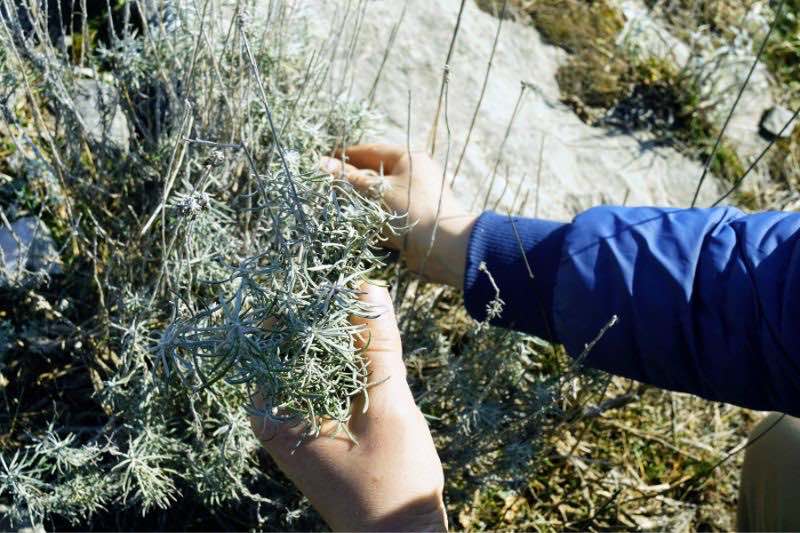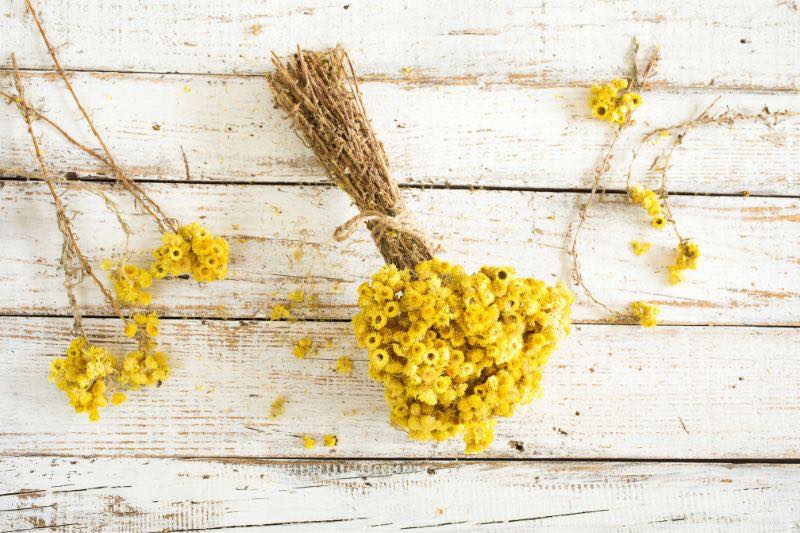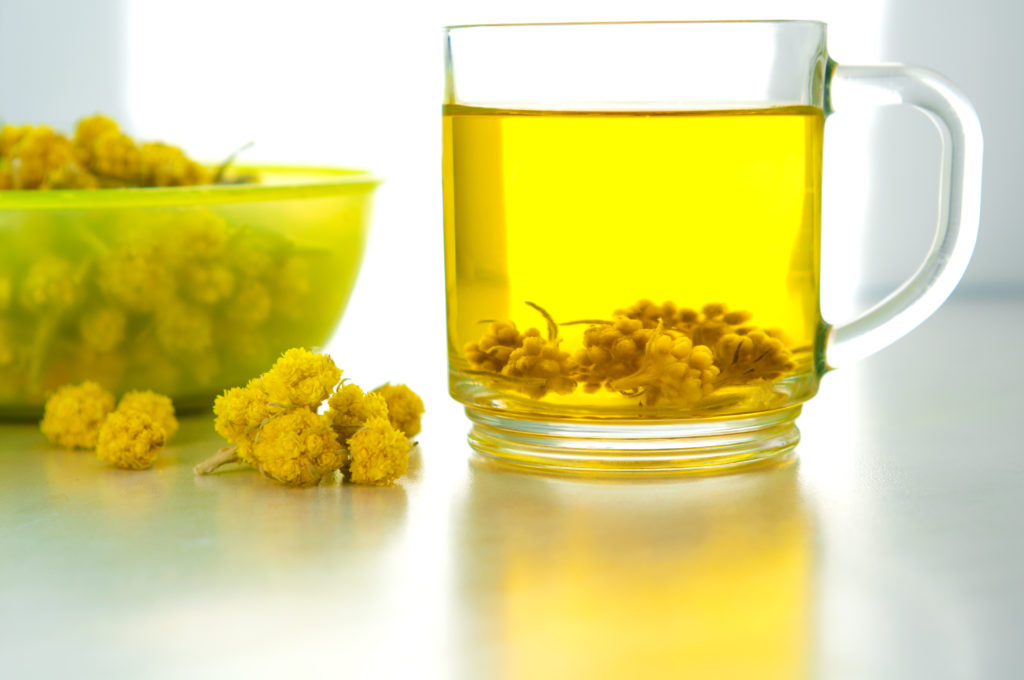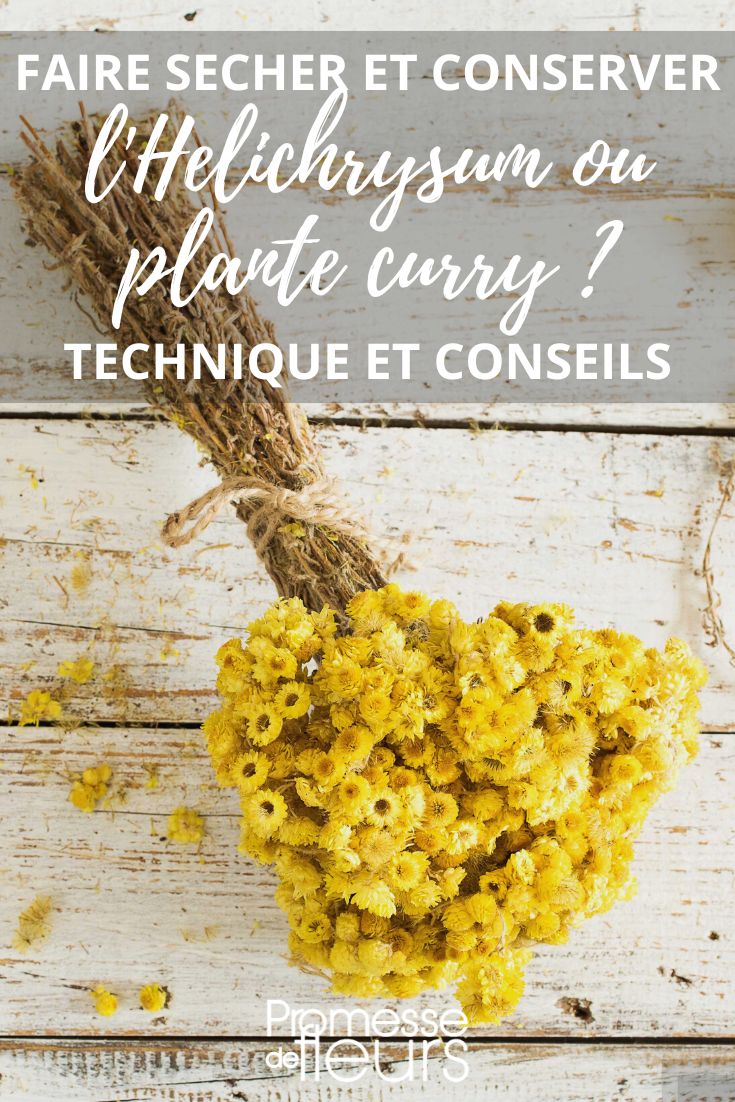Helichrysum is a Mediterranean perennial with many qualities: long flowering in golden-yellow pompons in summer, evergreen foliage with silvery grey leaves and a prized aromatic intensity used in cooking as well as in herbal medicine.
This curry plant grows equally well in open ground or in a pot, to adorn and scent all types of gardens.
Its stems and flowers can be easily dried for storage and use year-round. We explain step by step how to proceed to best preserve qualities of the Italian everlasting.

Harvesting Helichrysum
Harvest should ideally be carried out on a hot, dry day around midday, when plant is rich in aromatic particles. Simply use a clean, sharp pruning shear to cut Helichrysum stems. Shake stems gently upside down to remove any insects or impurities.
Note: avoid harvesting in plant’s first year after planting, to allow it to establish properly.
Harvesting leaves
In principle, stems can be harvested almost year-round, since leaves are evergreen. For drying, we nevertheless recommend favouring late spring, just before flowering (between May and June depending on region).
Harvesting flowers
Flower harvest takes place in early summer, around July, just before small flower pompons are fully open.

Three methods to dry Helichrysum
Air drying
Air drying has the advantage of being natural, economical and ecological. It requires no energy or specific equipment and helps preserve plant’s active principles by drying gently.
Drawback: it takes longer, requiring from one to several weeks depending on ambient temperature and technique chosen. Drying is successful when leaves or flowers crumble between fingers.
Space-saving technique for small areas
- Group stems into small bunches of around ten sprigs.
- Tie them together without over-tightening, using a piece of string or raffia (avoid elastic bands, which can compress stems too much and prevent air circulation).
- Hang upside down from a hook or shelf corner, in a warm, dry place, but protected from light and direct sun.
- If chosen location is dusty (shed, garage…), you can add a paper bag with holes or a sheet of newspaper around bouquet for protection (do not use plastic bag, which would stop drying and cause stems to rot).

Flat technique for quicker, optimal drying
- Spread the sprigs flat on a crate or drying rack.
- Arrange them with a few millimetres between each to encourage ventilation.
- Place in a warm, dry spot, but protected from light and direct sun.
- Turn sprigs regularly during drying.
- If location is dusty, you can cover sprigs with a piece of fine cloth for protection.
Oven drying
Oven drying has the advantage of being very quick. Poorly managed, it can however burn Helichrysum stems and flowers, or alter plant’s natural fragrance. Clearly, it consumes energy, so it is less natural, ecological and economical than air drying.
Drying time will vary according to oven and temperature chosen, but will generally require several hours.
- Place Helichrysum sprigs on a tray lined with baking parchment.
- Space them so they do not overlap.
- Set oven to the lowest possible temperature (around 60–80°C depending on model).
- Open oven door regularly to let moisture escape and check that sprigs are drying without “cooking”.
- Drying is complete when leaves or flowers crumble between fingers.
Dehydrator drying
Drying with a dehydrator also proves faster than natural air drying. It uses less energy than oven drying, but requires specific equipment.
Tutorial is same as for oven drying, but follow manufacturer’s instructions to choose appropriate temperature and drying time.
Storing dried Helichrysum
Keep leaves and flowers as they are in bunches or strip them from stems. In latter case, place in an airtight container, protected from humidity and light, stored at room temperature.
Dried Helichrysum sprigs will keep for about one year, but will gradually lose qualities: flowers may become less vivid and leaves less fragrant.
Use dried Helichrysum in bouquets for ornamental qualities
Like annual everlastings (bracted everlastings or Helichrysum bracteatum), whose flowers are superb in dried bouquets, those of Helichrysum italicum are also used for ornamental value and durability.
Use floral stems in a dried or fresh bouquet, monochrome or multi‑coloured. Only limits are your creativity! You can also make flower crowns, table centres, place stems in bud vases or frames in the manner of an Herbarium, etc.

Use dried Helichrysum in recipes for its aromatic flavour
Helichrysum leaves give off a powerful aromatic scent, which explains its nickname “curry plant”. They are best used fresh to maximise flavour, but drying allows enjoyment year-round.
Like a bouquet garni, gather 3–4 Helichrysum stems together, tied with a piece of string. Let infuse in a butter, milk or cream sauce (dairy or plant‑based). Also use in a stock, soup or marinade. The fuller the bundle, the more aromatic and intense the flavour. You can also use leaves for papillote cooking, steaming, on the grill, etc.
Be sure to remove bouquet or leaves at end of cooking: not very digestible, they are not suitable for eating.
Use dried Helichrysum in herbal medicine and cosmetics for its natural benefits
Italian everlasting is among precious and costly essential oils, prized in herbal medicine for many properties. Anti‑inflammatory, antioxidant, antiseptic, analgesic, antispasmodic, detoxifying, decongestant… curry plant is reputed to have many virtues. It is a staple of natural care for bruises and circulatory problems.
Distillation requires specific equipment and expertise, but various recipes for Helichrysum oil macerates are available online to make at home.
Flowers of Helichrysum arenarium or sand everlasting can be used as a tisane. For a cup (about 250 ml), allow about one teaspoon of dried flowers. Cover with just‑off‑the‑boil water and infuse for 10–15 minutes. Strain or use a tea ball. Drink 2–3 times a day. It is perfectly possible to add honey, sugar, ginger or any other flavouring to taste.
Flowers of Helichrysum italicum prepared as a tisane are rather used to make poultices or compresses for external application, for example to aid healing of a bruise.
We always advise consulting a professional, especially in case of health problems, or before use with children, pregnant or breastfeeding people.
Eucalyptus is also among effective moth‑repellent plants: discover how to use it for this purpose.

































Comments